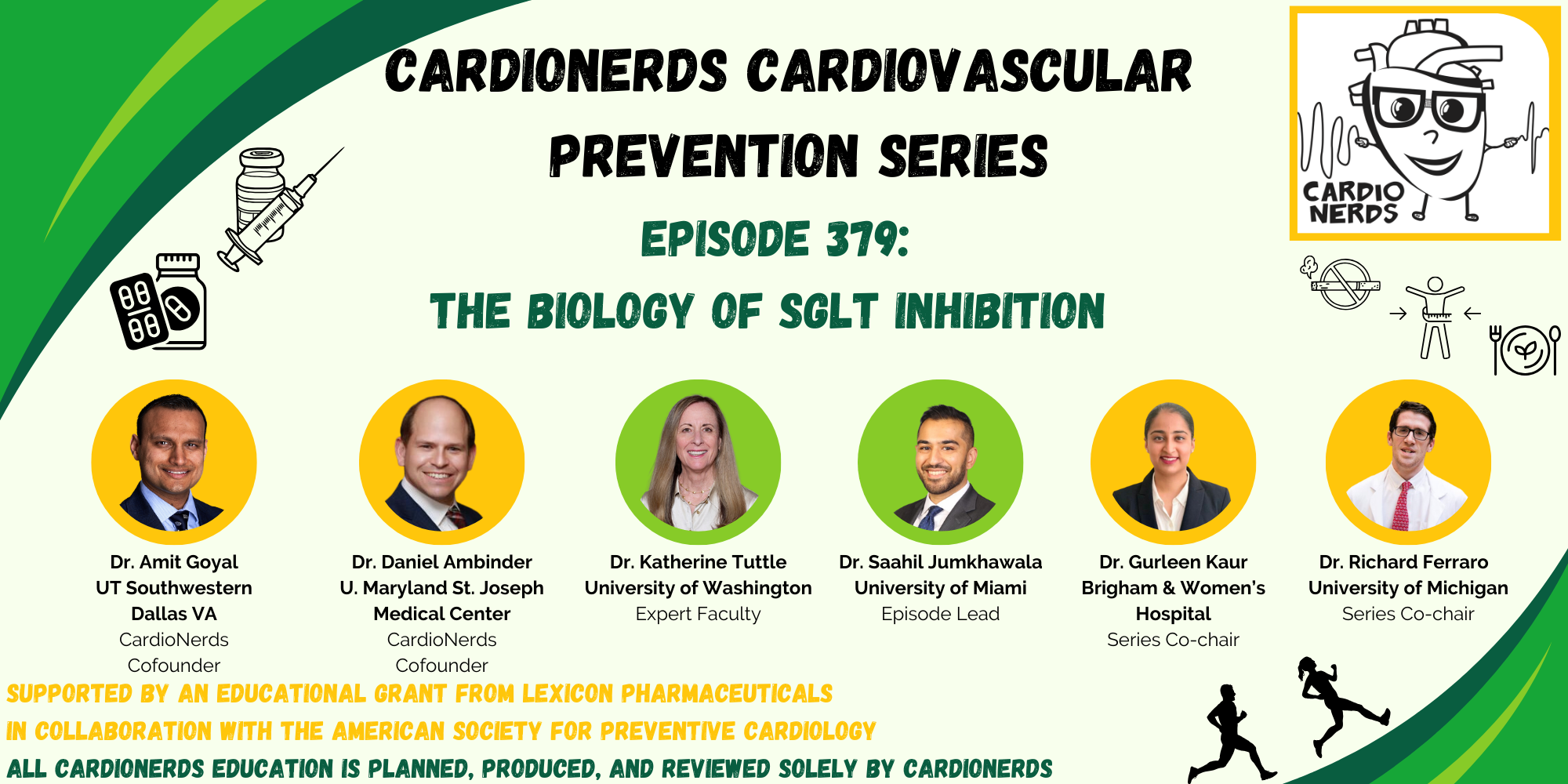Cardionerds: A Cardiology Podcast

379. SGLT Inhibitors: The Biology of SGLT Inhibition with Dr. Katherine Tuttle
CardioNerds (Drs. Gurleen Kaur and Richard Ferraro) and episode FIT Lead Dr. Saahil Jumkhawala (Cardiology Fellow at the University of Miami) discuss SGLT inhibitors, focusing on the biology of SGLT and its inhibition, with Dr. Katherine Tuttle (Executive Director for Research at Providence Healthcare, Co-Principal Investigator of the Institute of Translational Health Sciences, and Professor of Medicine at the University of Washington). Show notes were drafted by Dr. Saahil Jumkhawala. The episode audio was engineered by CardioNerds intern Christiana Dangas.
This episode was produced in collaboration with the American Society of Preventive Cardiology (ASPC) with independent medical education grant support from Lexicon Pharmaceuticals.
US Cardiology Review is now the official journal of CardioNerds! Submit your manuscript here.

CardioNerds Prevention Page
CardioNerds Episode Page
CardioNerds Academy
Cardionerds Healy Honor Roll
CardioNerds Journal Club
Subscribe to The Heartbeat Newsletter!
Check out CardioNerds SWAG!
Become a CardioNerds Patron!
Pearls – The Biology of SGLT Inhibition with Dr. Katherine Tuttle
- SGLT inhibitors, while initially developed as antidiabetic medications, have been shown to be beneficial for cardiovascular and renal outcomes. These benefits result from their on-target glucosuric effects and additional off-target effects.
- The side effect profiles of SGLTis are primarily mediated by glucose reabsorption in their target tissues. The side effect profile of SGLTis must be considered when prescribing these medications and is generally favorable for SGLT2is versus SGLT1is.
- Once SGLTis are prescribed, patients should be given specific attention to their eGFR, serum potassium, and clinical evaluations of volume status and blood pressure.
- Strategies to increase implementation of and reduce clinical inertia for these important class of medication remain an area of active investigation
Show notes – The Biology of SGLT Inhibition with Dr. Katherine Tuttle
What should prompt consideration of starting an SGLT inhibitor?
- Considerations for SGLT inhibitor initiation are based on a history of heart failure, kidney disease, and diabetes status.
- In the EMPA-KIDNEY trial, empagliflozin improved cardiovascular and kidney outcomes in those with low GFR (regardless of level of albuminuria).
What is the mechanism of action of SGLT2 inhibitors?
- SGLT2 inhibitors improve glycemic control by blocking SGLT2 receptor-mediated reabsorption of glucose in the proximal convoluted tubule, where 80-90% of this reuptake occurs, and increased downstream excretion of glucose and sodium chloride. SGLT2 inhibitors provide only a modest glucose-lowering effect, particularly for patients with GFR <45.
How do SGLT2 inhibitors improve cardiac function?
- Through corrected glomerular hyperfiltration, there is a reduction in blood pressure, a reduction in sympathetic neural activity, and increased glucosuria, improving diuresis. Systemically, there is an increase in erythropoietin, which raises red blood cell mass and oxygen-carrying capacity.
- Beyond inhibition of the SGLT2 receptor, which is isolated to the proximal convoluted tubule, there are additional off-target effects. Through non-receptor-mediated mechanisms, glucose transport is blocked into cells by blocking GLUT1 and GLUT4 receptors. They also reduce the mTORC signal transduction pathway, thereby reducing inflammation and glycolysis, leading to a cardioprotective effect in myocytes.
- In the DAPA-CKD and CREDENCE trials, GFR decreases of up to 30% were correlated with improved renal and cardiovascular outcomes.
- The cardiovascular benefit of SGLT2 inhibitors is not dose-dependent.
Where are SGLT1 receptors located?
- SGLT1 receptors are found primarily in small and large bowel enterocytes, as well as the kidney proximal tubule, beyond the convoluted segment.
- Around 10% of glucose re-uptake is mediated by SGLT1 receptors in the proximal tubule.
What are some common side effects of SGLT inhibitors?
- Given SGLT1 receptors’ presence in the gastrointestinal tract, the side effects of SGLT1 inhibition are primarily gastrointestinal upset through decreased glucose reabsorption in the gut.
- SGLT2 inhibitors’ side effects are primarily sequelae of glucosuria, particularly those of genitourinary infections, volume depletion, and euglycemic ketoacidosis (most commonly in patients with diabetes who are longstanding insulin users).
Additionally, a GFR decline of >30% should be suggestive of other issues for patients taking these medications, most commonly volume depletion or hypotension.
References – The Biology of SGLT Inhibition with Dr. Katherine Tuttle






 Visit Podcast Website
Visit Podcast Website RSS Podcast Feed
RSS Podcast Feed Subscribe
Subscribe
 Add to MyCast
Add to MyCast